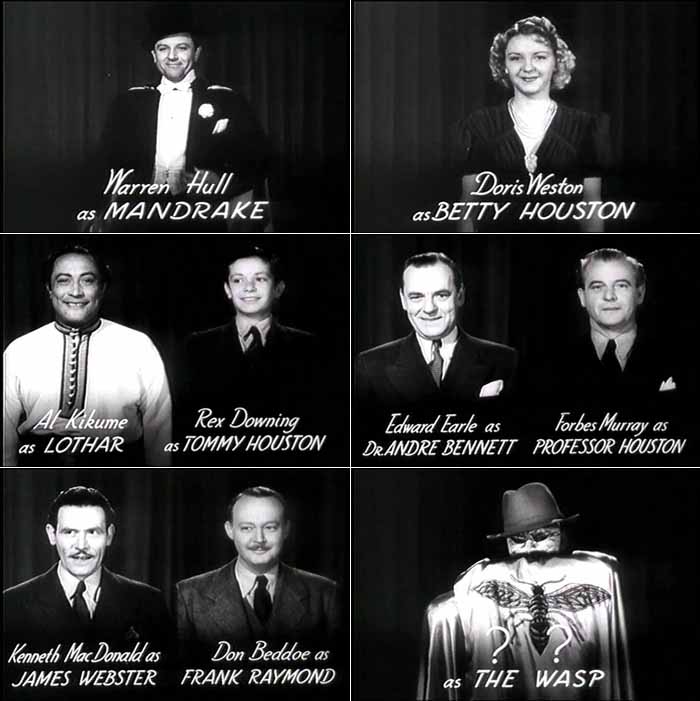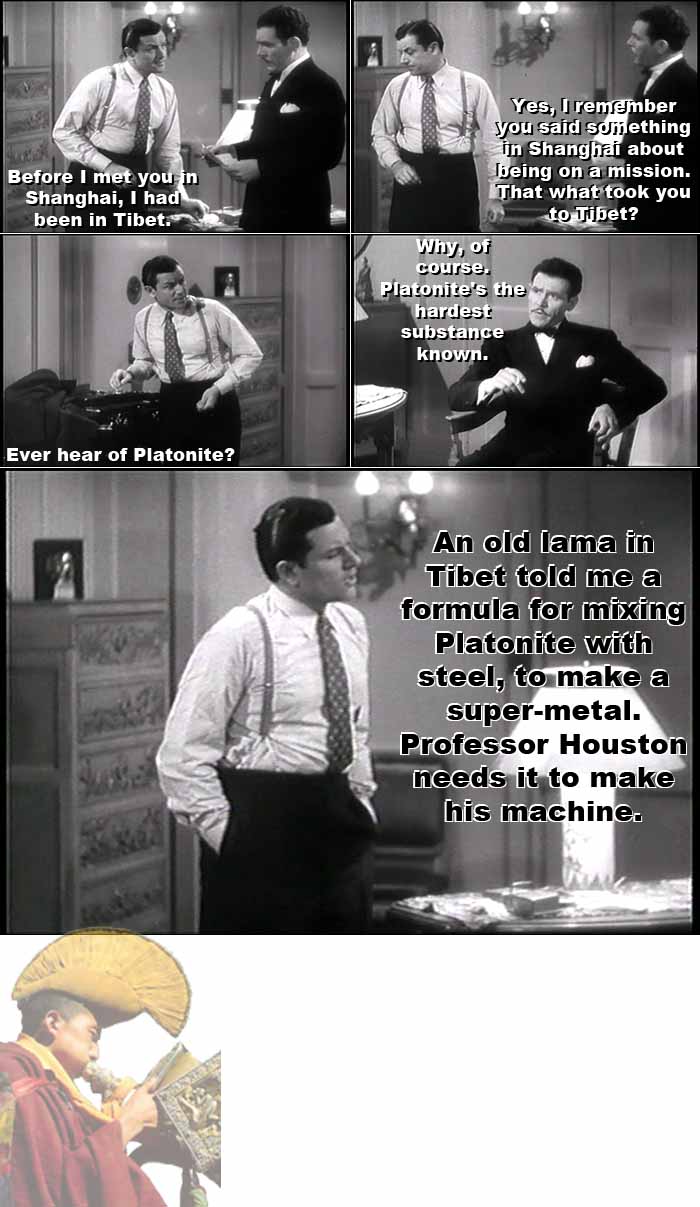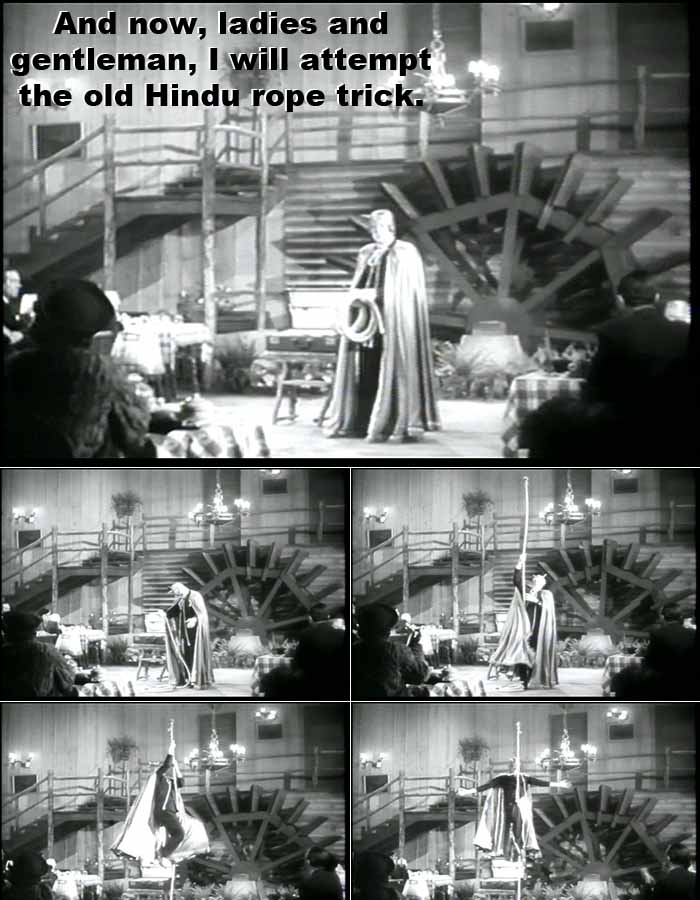
Mandrake the Magician
Medium: film
Publication date: 1939
Publisher:
1 characters in this story:
| Character (Click links for info about character and his/her religious practice, affiliation, etc.) |
Religious Affiliation |
Team(s) [Notes] |
Pub. | # app. |
|||||
|---|---|---|---|---|---|---|---|---|---|
|
|
Defenders of the Earth |   , etc. , etc. |
71 |
Mandrake the Magician is a 12-part serialized film. This serial brought to he big screen the classic daily comic strip character created by Phil Davis and Lee Falk.
Each segment of the Mandrake the Magician serial was approximately 18 minutes long. The film was originally shown in theaters over successive weeks. Audiences would attend theaters week after week to see the complete continuing story.
The DVD we viewed for this analysis was disc 1 of 2 (rented from Blockbuster). We are waiting to see disc 2, which is currently unavailable. The complete film actually a compilation of 12 episodes) is 215 minutes long. A complete list of episodes is as follows:
1. Shadow on the Wall
2. Trap of the Wasp
3. A City of Terror
4. The Secret Passage
5. The Devil's Playmate
6. The Fatal Crash
7. Gamble For Life
8. Across the Deadline
9. Terror Rides the Rails
10. The Unseen Monster
11. At the Stroke of Eight
12. The Reward of Treachery
BELOW: Menu screen VCI Home Video's DVD release of the 1939 'Mandrake the Magician' serial film:
Source: Mandrake the Magician (1939). Written by Joseph F. Poland, Basil Dickey, Ned Dandy. Directed by Norman Deming, Sam Nelson.
BELOW: Opening credits at the beginning of each episode highlight the film's 9 main characters:

Source: Mandrake the Magician (1939). Written by Joseph F. Poland, Basil Dickey, Ned Dandy. Directed by Norman Deming, Sam Nelson.
Timecode: Episode 1 ("Shadow on the Wall"), 2 minutes, 30 seconds: James Webster (a famous electrical engineer who is a recent acquaintance of Mandrake) is visiting Mandrake the Magician in his quarters on a cruise ship while he gets ready to perform a show. They are discussing a telegram that Mandrake just received from Betty Houston about her father's research with radium. Early in the film, this is the very first scene in which we see Mandrake.
Mandrake seems concerned by the telegram, which says:
MR. MANDRAKE
ABOARD S.S. MOHAWK
WORRIED ABOUT FATHER. AM SURE DANGER
THREATENS HIM BECAUSE OF RECENT INVENTION.
PLEASE COME TO HOUSE DIRECT FROM BOAT.
BETTY HOUSTON
James Webster: What's a matter, bad news?
[Mandrake hands Webster the telegram.]
Mandrake the Magician: Read that. It's from Professor Houston's daughter.
James Webster: Houston? The radium authority?
Mandrake the Magician: Yes. Houston has been perfecting a machine to perfect radium energy. You know how vital radium is for medical use. This machine, when completed, will do all radium does, and more. It's just as effective, and lots easier to handle.
James Webster: How nearly finished is it?
BELOW: Mandrake the Magician explains that he received an important formula from an old lama (Buddhist monk) in Tibet:

Source: Mandrake the Magician (1939). Written by Joseph F. Poland, Basil Dickey, Ned Dandy. Directed by Norman Deming, Sam Nelson.
Mandrake the Magician: Only professor Houston knows. Because of that, I'm worried about this message. Before I met you in Shanghai, I had been in Tibet.
James Webster: Yes, I remember you said something in Shanghai about being on a mission. That what took you to Tibet?
Mandrake the Magician: Ever hear of Platonite?
James Webster: Why, of course. Platonite's the hardest substance known.
Mandrake the Magician: An old lama in Tibet told me a formula for mixing Platonite with steel, to make a super-metal. Professor Houston needs it to make his machine.
James Webster: If Platonite's as rare as radium, where could you find it?
Mandrake the Magician: Actually, that's only part of it. I've looked all over the world for it, and now I've discovered that it can be found in only one spot in the United States.
James Webster: Yeah, but where?
Mandrake the Magician: Can we let that remain a secret for the time being?
James Webster: Whatever you say. But I still can't understand why Houston would be in danger.
Mandrake the Magician: Because his radium machine, while it can be a great boon to humanity, can also be a very destructive force in the hands of racketeers or crooks. But let's forget about that. Now I have to get ready for the show.
James Webster: All right, take your time, Mandrake. I'll be waiting for you in the salon.
[The ship's passengers attend a costume ball at which the climax of the festivities is a performance by Mandrake the Magician.]
Timecode: Episode 1 ("Shadow on the Wall"), 5 minutes, 35 seconds: Mandrake is performing a magic show for the cruise ship passengers.
BELOW: Mandrake the Magician's upbringing in Tibet is further hinted at during a performance when he introduces his next trick as one he brought from that 'hidden land':
Source: Mandrake the Magician (1939). Written by Joseph F. Poland, Basil Dickey, Ned Dandy. Directed by Norman Deming, Sam Nelson.
Mandrake the Magician: My next trick will be one that I've brought from the hidden land of Tibet.
[Mandrake performs a traditional magician's trick with a candle, a metal tube, and a bouquet of flowers.]
Timecode: Episode 3 ("A City of Terror"), 7 minutes, 8 seconds: Mandrake the Magician wears a ceremonial robe that looks like something out of Tibetan Buddhism or Eastern Lamaism. He wears this special robe so to an interrogation session, in which he interrogates a prisoner (using just a bit of electroshock torture). The prisoner is one of the criminals who works for the mysterious criminal known only as The Wasp. Criminals working for the Wasp have kidnapped Professor Houston (the father of Mandrake's girlfriend) and stolen his improved radium machine. When Mandrake is through interrogating the prisoner, he removes the robe so that he is once again wearing only a tuxedo or dark black suit.
BELOW: The robe that Mandrake the Magician wears while conducting an interrogation appears to be a ceremonial robe from Tibetan Buddhism:
Source: Mandrake the Magician (1939). Written by Joseph F. Poland, Basil Dickey, Ned Dandy. Directed by Norman Deming, Sam Nelson.
Timecode: Episode 3 ("A City of Terror"), 13 minutes, 0 seconds: The Wasp sees that his men are having a hard time capturing or killing Mandrake the Magician. So he sends somebody else to help, a powerful hypnotist named Regan. Regan disguises himself as the world's foremost performing hypnotist, Frederick Leland, and meets with Mandrake. But Mandrake knows that Leland is on tour, and that this man is a fraud in disguise.
Mandrake the Magician: [greeting Regan disguised as Leland, and shaking his hand] Professor Leland, I've heard of you oftn.
Regan (disguised as Leland): Mandrake the Magician. I've long wanted to know you.
Mandrake the Magician: Thanks. Won't you sit down.
Regan (disguised as Leland): Thank you.
Mandrake the Magician: What can I do for you?
Regan (disguised as Leland): I have a proposal, one that I've long considered, that you and I combine our shows.
Mandrake the Magician: I've never felt the need of a partner before. Just what do you propose to do?
BELOW: Fellow magician Regan (who is also a leading hypnotist) describes Mandrake as the 'foremost' of his profession:

Source: Mandrake the Magician (1939). Written by Joseph F. Poland, Basil Dickey, Ned Dandy. Directed by Norman Deming, Sam Nelson.
Regan (disguised as Leland): Ah, let me show you what I mean. Everyone knows that you are the foremost of your profession. And that I, Leland, can hypnotize anyone.
[Regan, disguised as Leland, holds up his hand and waves them, fingers spread apart, in front of Mandrake's face. He thus begins using his prodigious hypnotic powers on Mandrake.]
Regan (disguised as Leland): Without anything but the power of the mind, I can induce sleep, and obedience.
Mandrake the Magician: I don't quite see how you plan to help me.
Regan (disguised as Leland): You did not understand me. What I said was, sleep and obedience. Sleep. Sleep. Sleep. Sleep.
[Regan continues waving his hands in front of Mandrake and looking into Mandrake's eyes hypnotically. Mandrake now pretends to fall under the hypnotic spell. He pretends to sleep and then he acts as if he has been hypnotized, so he will be brought to the hideout of the bad guys, hopefully to someplace where he can find Professor Houston or find clues that will lead him to the Professor.]
Timecode: Episode 3 ("A City of Terror"), 14 minutes, 31 seconds: As Mandrake leaves his apartment, he winks at his assistant, Lothar. Thus, Lothar smiles as he sees Mandrake being led away by the hypnotist Regan. Lothar will discreetly follow the bad guys, as Mandrake instructed him to.
BELOW: Mandrake's African assistant Lothar smiles as he sees Mandrake's plan is working. Lothar's more 'civilized' outfit is quite different from the cheetah skin he traditionally wore in the Mandrake comic strip:
Source: Mandrake the Magician (1939). Written by Joseph F. Poland, Basil Dickey, Ned Dandy. Directed by Norman Deming, Sam Nelson.
[Note: Unlike the previous 3 episodes that are part of this 6-episode serialized film, Episode 4 on this DVD does not start over at 0 minutes, 0 seconds in its timecode. When Episode 4 begins on this DVD, the timecode is at about 18 minutes.]
Timecode: Episode 4 ("The Secret Passage"), 32 minutes, 41 seconds: Mandrake the Magician is wearing what is essentially a devil costume. He wears mask, hood and cape (all apparently red). The hood has two horns coming out of the forehead, so that Mandrake appear to be dressed sort of as a devil. The reason Mandrake is wearing this disguise is that he is masquerading as the magician-hypnotist Regan, who was to perform at the Mill River Inn, until Mandrake interrupted the man and took his place by donning his outfit. Needless to say, Mandrake does not normally dress like a devil. And there is not anything particularly "devilish" or "Satanic" implied by this particular devil-like mask and hood. It is simply a costume for a magician. It isn't even a costume and mask that Regan wears regularly. He was only going to wear it because the Inn owners insisted he wear a mask for this performance. Perhaps when performing his act he regularly wears the hood (with the horns) and not the mask. We can't be can't be certain.
BELOW: Mandrake is disguised in a magician's mask, hood, and cape with a clear devil motif. This is not his outfit, but one he wears to impersonate the criminal magician named Regan:
Source: Mandrake the Magician (1939). Written by Joseph F. Poland, Basil Dickey, Ned Dandy. Directed by Norman Deming, Sam Nelson.
Timecode: Episode 4 ("The Secret Passage"), 32 minutes, 58 seconds: Mandrake continues to perform a magic act for the assembled crowd. Mandrake is trying to be in place to make contact with the bad guys who still hold Professor Houston captive.
BELOW: Mandrake performs the Hindu rope trick:

Source: Mandrake the Magician (1939). Written by Joseph F. Poland, Basil Dickey, Ned Dandy. Directed by Norman Deming, Sam Nelson.
Mandrake the Magician: And now, ladies and gentleman, I will attempt the old Hindu rope trick.
[Mandrake drops the bulk of a thick rope onto the floor, keeping just one end in his hand. He tosses the end of the rope into the air and it stays in the air, about 6 feet above his head, as if hung from something invisible in mid-air. The rope straightens. The crowd claps appreciatively. Then Mandrake actually climbs the rope! He even releases a couple of doves, which seem to materialize in his hands, while he is up on the magically "suspended" rope.]
[Henchmen of the Wasp are waiting to bring hypnotist/magician Regan back to their hideout after he performs his magic act. They watch Mandrake perform, not realizing that it is Mandrake. After Mandrake performs the "old Hindu rope trick" a newly arrived henchman recognizes Mandrake, even though he is wearing Regan's mask. The henchmen all rush forward to get Mandrake. A terrific fight scene ensues, pitting Mandrake against about six of the Wasp's henchmen. Mandrake is barely able to escape with his life. But once he does escape, he is none the worst for wear.]
Timecode: Episode 5 ("The Devil's Playmate"), 36 minutes, 52 seconds: As episode 5 begins (once again, not starting from time-point zero on this DVD), we see the title card screen showing that Chapter 5 is titled "The Devil's Playmate." Obviously this title has clear religious undertones. What is meant by this title? Is this simply referring to the devil mask and hood worn by Mandrake at the conclusion of the previous episode? Or will this refer to something else?
Well, by the end of the episode, there do not seem to be any other references to "devils" or "playmates." This series has shown that the "scenes from next week" previous at the end of each episode are not necessarily accurate, and it is likely that "The Devil's Playmate" simpy seemed like an intriguing title. The only real meaning we can see for this title is the fact that Mandrake wore a devil's costume at the very beginning of the episode.
The only alternative we can see is that the title refers vaguely to the villain of this serial: The Wasp. The Wasp is using the radium machine he stole to commit acts of terrorism, including the destruction of a radio station in the previous episode and the destruction of a power plant in this episode. Each of these acts of destruction was also intended to destroy Mandrake the Magician, but the hero escaped each time. So the Wasp can be regarded as "devilish," simply because he is an evil criminal. But he isn't any more "the Devil's playmate" than any other nefarious pulp villain. The Wasp uses theatrics and a mask, but these are just to enhance the air of mystery about him, make others fearful, hide his identity, etc. There is nothing overtly Satanic or occult about him.
Timecode: Episode 6 ("The Fatal Crash"), 4 minutes, 46 seconds: The Wasp remotely triggers the release of poisonous into the hideout of his henchmen, thus murdering one of his henchmen who failed him when the recent mission to destroy Mandrake failed. This is a good example of The Wasp's cold-hearted evil, but this isn't particularly surprising. Pulp villains typically are willing to murder their own henchmen who fail them. The Wasp has certainly been shown as being willing to murder other people before. He simply hasn't been very successful in his attemps to kill Mandrake, Lothar, and Betty Houston.
Regardless of how Mandrake the Magician is portrayed in other stories and media, it is worth noting that in this 6-episode serialized film, Mandrake never demonstrates any supernatural or occultic powers. He is an extremely talented magician, referred to as the foremost practitioner of his craft. He is also a decent fighter, using what is mostly a scrappy boxing style. But he does not appear to have any "powers" beyond what a determined man could learn with practice, study and diligence. Mandrake the Magician, as portrayed here, is the world's greatest traditional stage magician. He is not a wizard or magic-user in any supernatural sense. He doesn't even try to portray himself as such as part of his magic act.